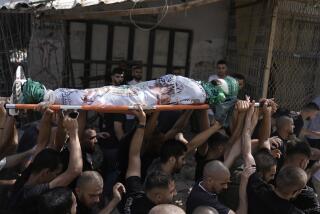In One Croatian Town, Cease-Fire Is Holding : Yugoslavia: Fighting is reported elsewhere, but it appears to be lighter than in previous days.
VARAZDIN, Croatia — The shooting had virtually stopped Thursday in this usually quiet Croatian town.
After a weekend of turmoil--firefights between Croatian guardsmen and Yugoslav federal army units, a bombing attack on the local airfield and artillery shells lobbed in the direction of the old town square--a tenuous cease-fire was holding here and the combatants were gingerly talking with one another.
It was the second day in the latest of several cease-fire attempts in Yugoslavia, this one negotiated by the former British foreign secretary, Lord Carrington, and signed by leaders of Croatia, Serbia and the army.
Although fighting was reported Thursday in several areas of Croatia, it appeared to be lighter than it has been in several days, and it was not yet certain that the cease-fire had come to an outright failure.
There were, however, ominous signs that none of the parties to the fighting--the Serbs, the Croats or the army--was ready to back down.
A six-mile column of tanks, armored vehicles and trucks, loaded with newly activated Serbian reservists, pulled out of the federal capital of Belgrade on Thursday, heading north toward Croatia.
Thousands of Serbian partisans cheered the passage of the army units, assuming they were on their way to battle Croatian forces. There was no word from army headquarters about where the forces were heading.
The Yugoslav news agency Tanjug reported that Croatian forces continued to attack federal barracks in the coastal city of Sibenik. Heavy shelling was reported by Belgrade Radio as the army fought to break the siege, the Associated Press said.
Belgrade Radio reported shelling and shooting in and around Osijek, eastern Croatia’s main city. Military sources confirmed that Croats occupied the army barracks there, but only after soldiers managed to move out most of their equipment. Barracks in Vukovar and nearby Vinkovci, in eastern Croatia, were also under attack, Tanjug said, citing a military statement. And street fighting had broken out in Gospic, near the Adriatic.
The Croatian Defense Ministry reported that an army munitions warehouse in Ogulin, southeast of Rijeka, was set ablaze by federal jets to keep it out of Croatian hands, and up to 20 federal soldiers were killed.
In Varazdin, a town of 45,000 about 60 miles northeast of Zagreb, the Croatian capital, the local Croatian military commanders and town officials were quietly celebrating a victory of sorts, having forced the withdrawal of about 120 soldiers and officers from one of the two federal military installations in town.
“We let them put on civilian clothes and sent them home,” said Kresimir Cop, one of the Croatian national guard commanders, adding that Croatian forces had taken control of the installation’s batteries of rocket launchers and artillery.
The other military facility, with 450 officers and soldiers, was still holding out, still surrounded and blockaded, but negotiations, officials said, are under way that might return the town to its normal, quiet state. “We didn’t come to full agreement,” said Cedemir Cesarec, the leader of the town’s management council, “but a step has been taken.”
In the long run, however, he was gloomy about the prospects for the latest cease-fire. “In my opinion,” he went on, “we (Croatia) waited too long to fight back, until almost two-thirds of our territory was taken, hoping that international appeals would have some effect.”
It all came to nothing, he said, and now “unfortunately, yes,” he believed there would be a war, despite Lord Carrington’s efforts and the hand-wringing of the European Community.
Varazdin, deep in Croatian territory and well away from Serbia’s territorial claims, had been spared fighting until last weekend. Then the Croatian government ordered all army installations in Croatia to be blockaded.
The army, although it is officially neutral in the fight between the breakaway Croatian republic and the Serbs, has been throwing its considerable might behind Serbian guerrilla groups. Varazdin police and national guard units on Saturday duly surrounded the two military installations in town and cut off their water and electricity.
The next day, Sunday, federal air force planes strafed and bombed the local airport. Shooting broke out between the surrounded army units and Croatian forces. The hard-line Serbian commander of the largest post, Col. Berislav Popov, with 450 men of his tank battalion, fired a few cannon shots toward the Varazdin town hall.
Although an increasingly shrill Croatian television described “extensive damage” in the old town center--Varazdin was the capital of Croatia for a brief period in the 18th Century--the damage was relatively light. Officials said that for all the noise, only two people were killed and two injured.
Varazdin’s population is 96% Croatian; the 1% of the population that is Serbian is made up mostly of army personnel, or those who came to the area with the army, then stayed on. It is not a place accustomed to ethnic strife, and, in fact, does not give the impression of a place that is looking forward to more conflict.
The most effective weapon used by the Croatians against the army units, evidently, was the sentiment of home and hearth. Early Thursday, appeals were broadcast over the local radio station from wives and children of the soldiers inside, pleading for them to give up their resistance and leave the barracks. One appeal came from a 4-year-old daughter of a soldier in the besieged camp. “Daddy, please come home,” she said.
A couple of hours later, along with his fellow soldiers, he did, and the siege was over.
More to Read
Sign up for Essential California
The most important California stories and recommendations in your inbox every morning.
You may occasionally receive promotional content from the Los Angeles Times.










